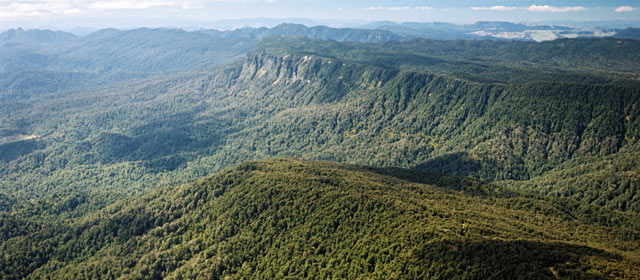Story summary
Origins
When the Mataatua canoe arrived in the Bay of Plenty, the voyagers found three tribes already living there – Ngā Pōtiki, Te Tini o Toi and Te Hapū-oneone. The Mataatua sailed north with most of the crew, leaving only the captain, Toroa, and his family. They intermarried with the original people and over time the Tūhoe people emerged.
The name of the tribe
The tribe take their name from Tūhoe-pōtiki (or Tūhoe), a great-grandson of Toroa. He and his brothers fought over the land and resources; Tūhoe won. He settled and eventually died at Kāwhia on the North Island’s west coast, but his descendants remained on the land in Te Urewera.
Te Urewera territory
The Tūhoe region is heavily forested, steep country, with fast-running, north-flowing rivers. The people lived mostly in river valleys and small forest clearings. As there was little farming land, they relied on the forests for food, clothing and shelter. They moved from place to place as the seasons changed. Maungapōhatu is the sacred mountain, and Lake Waikaremoana is ‘the bathing waters of the ancestors’.
The wars of the 1860s and early 1870s
Because they lived so far from centres of trade, Tūhoe contact with Europeans came much later than for other tribes. But they did trade with other Māori for European goods such as livestock and seeds. Their first major contact with Europeans came during the wars of the 1860s. Tūhoe fought the government in the battle of Ōrākau in 1864. They were wrongly accused of being in rebellion when a missionary was killed in Ōpōtiki, and their fertile lands were taken. Worse was to follow when government troops invaded Te Urewera in search of Te Kooti Arikirangi, a prophet and resistance leader from the East Coast.
Resistance
Te Kooti began a campaign against government forces in Poverty Bay in 1868. Tūhoe people sheltered and supported him. In response, the government destroyed their homes. After the suffering caused by the wars, the tribe closed their doors to the outside world. They refused to survey, lease or sell their land, and forbade the building of roads.
Religion
Many Tūhoe belong to Ringatū, the faith started by Te Kooti. In the early 1900s a new religious leader, Rua Kēnana, started a thriving community at Maungapōhatu, to which people from many tribes were drawn. The government was suspicious of his teachings and activities, and in 1916 he was arrested and imprisoned.
Tūhoe today
Every two years, Tūhoe people from around New Zealand gather to celebrate their heritage at Te Hui Ahurei. Tūhoe still live and hunt for food in Te Urewera. One of the challenges the tribe faces is to maintain their identity in a changing world. In the 2013 census, 34,890 people claimed Ngāi Tūhoe descent.





